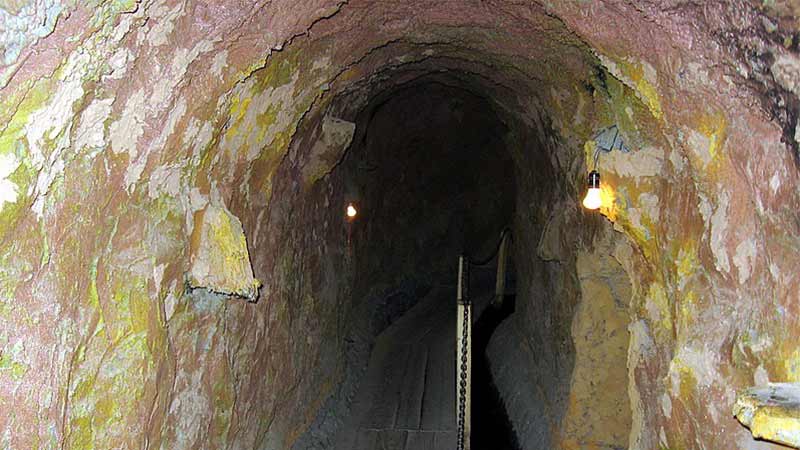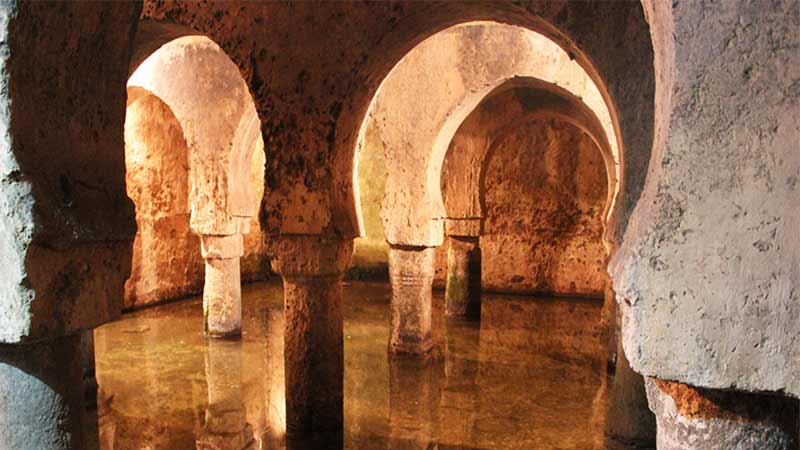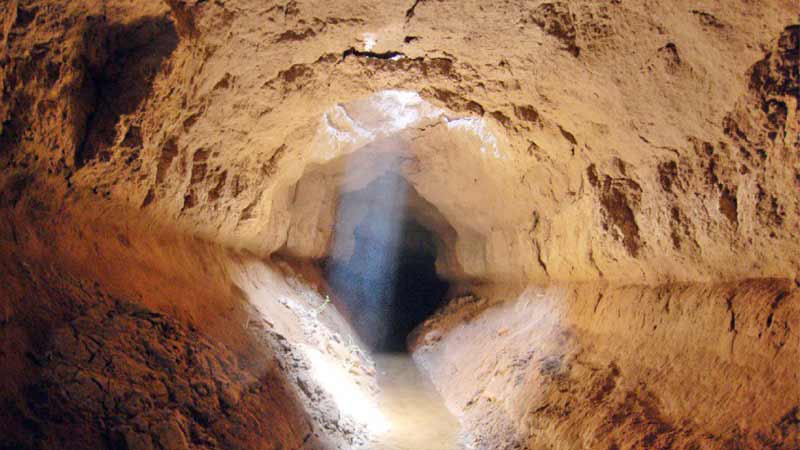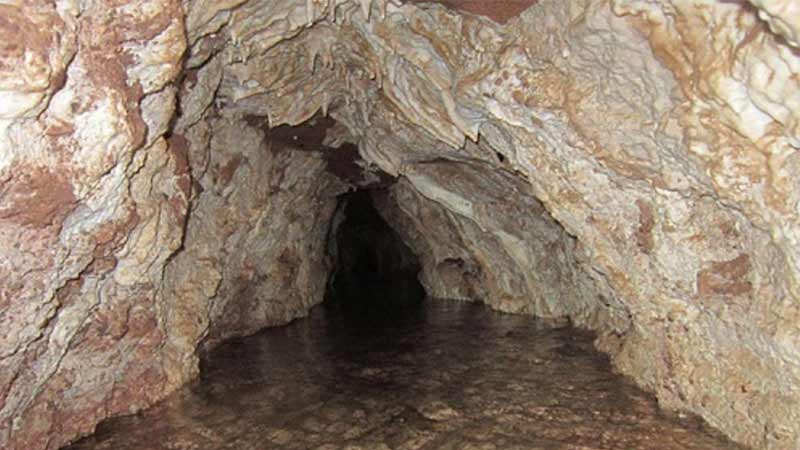Getting water from the depths of the earth is not an easy task, especially in places where there is no water. That’s why desert cities or those on the edge of deserts were pioneers in extracting water from the ground. The water structures of our ancestors show the depth of Iranian thought and their mastery in water engineering. Join us to learn about the most important of these structures, the qanat.
What is a Qanat?
A qanat is a tunnel-like channel dug under the ground to flow water. This channel, deep in the earth, connects a series of wells starting from a ‘mother well’ to direct and manage water for agriculture and other uses. These channels can be thousands of meters long before they reach the surface, where the water emerges, known as the qanat’s outlet or mouth.
Evidence suggests that Iranians knew and used qanats from 3800 years ago. This technology gradually spread from Iran to North Africa, China, and parts of South America like Chile. The technology of building qanats expanded in the arid mountainous regions of Iran in the early first millennium BC, allowing farmers to cultivate during long drought periods when there was no surface water. These qanats gradually became common in other parts of the world, and now many qanats exist from China to Morocco and even in the Americas.

Background of Qanats
With the invention of the qanat, a unique technology at the time, a significant amount of groundwater could be collected and brought to the surface. Like natural springs, this water flows all year round without any mechanical aid, bringing greenery and fruit gardens. This profession also brought the water clock and the water mill. The age of many Iranian qanats exceeds five to six thousand years, as old as the ancient history of Iran. However, this method of water use is still common in some villages and agricultural and pastoral areas of the country and is even the mainstay of cultivation in dry areas. Goblot believes that the qanat was not initially a special irrigation technique but entirely derived from mining techniques. It was meant to collect nuisance underground waters (waste waters) during mining. Although copper and possibly zinc mines in the Zagros Mountains were exploited in the second millennium BC, Goblot’s view does not seem very scientific and does not match field studies on Iranian qanats.
Kariz
The kariz consists of an open entrance or heranj and a sloping underground channel with several vertical wells that connect the underground channel to the surface. The wells – referred to as poles when digging – serve to transport excavated materials to the surface, ventilate the underground channel, and provide access for cleaning, repairing, and inspecting the kariz. The place where the water exits the qanat is also called the mouth.
The start of the kariz is the same as the entrance, also known as the ‘mouth of the kariz.’ This is where the water comes out and becomes visible, and can be used for irrigation and other purposes. The end part of the kariz, called the ‘forefront of the kariz,’ contains the mother well of the kariz. Parts of the kariz that are dry and have no water yet are called ‘dry work,’ and the water-bearing part (the end part) is called the ‘water-yielding kariz.’

Digging a kariz usually starts from its mouth, which is the dry ground level, and ends in the water-yielding areas of the mother well. Therefore, first, the dry heranj or entrance is dug, followed by the first wells or poles, which are also dry and part of the ‘dry work’ of the kariz. Then the work continues towards the upstream parts, i.e., the water-yielding and more water-rich areas of the ground.
The Beginning and End of a Qanat
If you look at a qanat from the sky, you will see a row of entrances stretching from the dry foothills to a green spot, a village, or a city. These entrances, wells, or poles lead to a long channel; the qanat. These wells are not for extracting water but are dug to create the underground channel or qanat. It’s a clever invention, right? Instead of pulling up water with a rope each time, you pull up the soil once and for many years, the water itself comes out of the earth. This is the Iranian miracle in the heart of the desert.
The length of a kariz varies depending on natural conditions, like the slope of the land and the depth of the mother well. The lower the groundwater level, the deeper the mother well needs to be. The most important factor determining the length of a kariz is the land’s slope. The longest qanat ever dug in Iran is near Gonabad in Khorasan, with a length of 70 kilometers, and the deepest mother well of Iran’s qanats is reportedly 400 meters or 350 meters deep, belonging to the Qanat-e Qasabeh Gonabad. The longer the ground slope, the longer the kariz, and the steeper the slope, the shorter the kariz.
Since the invention of the qanat, water distribution among shareholders has been done by a water master using a water clock or cup. The cup is a small bowl with a hole in the middle and several marked degrees on its inner body, placed on the waters of a large pot.

Water Clock
The operation of the cup or water clock involved the water master watching the cup fill and sink, touching the bottom of the pot for each cup or seven and a half dings (7.5 minutes in today’s time). He would place a small stone in a bag or pottery vessel for each sinking of the bowl to accurately calculate the number of cups and the time a qanat shareholder took water for their garden or land. For example, if there are 10 stones in the bag, it means the person has used 10 cups or 75 minutes of qanat water. If a person had 10 cups of share from the qanat, it meant the time it took for 10 cups of water to fill, and the qanat water was released to their land or garden. The next person would then transfer the water to their land or garden by blowing a horn or making a contractual sound. The permanent location of the cup and its manager (the water master) was the cup house. However, in summer, the cup was sometimes taken to the main water distribution point. Callisthenes, a Greek historian who accompanied Alexander the Great on his campaign to Iran and regularly recorded his observations and events, wrote in a note dated September 328 BC:
“Here (in Iran), in the villages where water is given to farmers in turn for agriculture, one of them (farmers) is chosen to supervise the time of rotation (and division of time shares). This person sits on a platform beside the main water channel and the place where it diverges among the farmers, placing a metal vessel with a very small hole in it in a larger and full water container. After the small vessel fills (once or several times) slowly and according to the pre-calculated dimensions of its hole, he cuts off the water and opens it to another farmer’s canal. This is a permanent procedure, and this device (the water clock) establishes justice and prevents farmers from quarreling over water.”
Features of a Qanat
The extraction system in a qanat is such that water is extracted from the ground without any cost or effort, just using gravity. Considering the existing wells and qanats, qanat water is cheaper than water extracted from wells. Qanat water is permanent and does not stop in emergencies, sensitive times, or during cultivation needs. Underground water sources last longer and are used over a long period, even if the water is constantly flowing out, whether used or not. A qanat has many advantages, only a few of which are mentioned here.

There are some structures associated with qanats that we will mention here:
Water Storage Tanks
These are covered pools or tanks, usually built underground, for storing water. Nowadays, some of these ancient water tanks still exist. In arid and desert regions, these tanks were filled with rainwater, seasonal streams, or water directed from qanats. The water was mostly stored in winter and used in summer.
Ice Houses
These structures were built for the production and storage of ice. Ice was made in the ice house pool especially during winter. After the ice was formed, it was broken into pieces and stored in a storage pit (known as an ice chamber) inside the ice house, and used during the warm season. To make ice in these ice houses, during the cold winter nights, water from qanats or canals was directed to an ice-making pool or tank beside the ice house. After the ice formed in this pool, it was broken up and stored in the ice house’s storage pit for use in summer.
Payab
Payabs are places built for easy access to the underground water passage of the qanat. A payab is accessed by stairs leading down from the ground level. Payabs served as recreational spots due to their cool air and were used both privately and publicly. The main space of a payab was usually a room shaped as a square or octagon. At the base of the payab, there was usually a pool through which the water of the qanat flowed and then exited.
Water Mills
Underground water mills were located several meters below the ground. Above these mills, water from a well or qanat flowed. This water turned the mill’s blades and the grinding stone, thus converting wheat into flour underground.
Qanats of Iran
According to statistics provided in 2010, there were 36,300 active qanat channels, with an estimated total length of 217,800 kilometers for qanat tunnels and 158,268 kilometers for qanat rods. The Zarch qanat, with an age of between 2,000 to 3,000 years and a length of 71 kilometers, is known as one of the longest qanats in Iran. The deepest mother well is located in the city of Gonabad, named Qanat-e Qasabeh, dating back to the Achaemenid era, with a length of 33,135 meters. The depth of the main channel’s mother well is 217 meters, and the depth of the Dolab Noo branch’s mother well is approximately 300 meters. The world’s only two-level qanat, the Moone Ardistan qanat, is located in the Moone neighborhood of Ardistan in Isfahan province. This qanat has two separate water flows on each level, interestingly without any mixing of the waters. This qanat was constructed 800 years ago. Following is a brief mention of the most unique qanats in Iran:
Ardistan; Two-Level Qanat: Have you ever heard of a two-level qanat? In Ardistan, there is a two-level qanat, meaning two water channels flow parallel to each other for 2 kilometers. This is the only two-level qanat in Iran.
Gonabad; 300 Meters Underground: It seems somewhat strange that a 300-meter-deep well was dug hundreds of years ago without today’s tools. But the creative minds of Iranians found a unique way. This qanat was built in a stair-like fashion, where every 100 meters, a step was created, and so on.
Kashan; Center of Qanat Civilization: If we consider Kashan as the center of a circle with a radius of 100 or 120 kilometers, most areas with astonishing qanats and unique features are located within this circle.
Ebrahimabad; Conical Qanat: On the road from Qom to Arak, there is a village named Ebrahimabad, where the only qanat is over a thousand years old. The mother well of this qanat is conical, meaning it widens as it goes deeper.
Meymeh; Underground Dam: There is also an underground dam. In winters, the water in the qanat increased, and to store this water for summer, they built a dam. The qanat in Meymeh, Isfahan, has a dam 9 meters high, made of stone and mortar. In winters, water accumulated behind the dam, and in summer, they would break the seal to release the water.
Yazd; Longest Qanat: There is a qanat in Yazd which is 120 kilometers long. There is no other qanat in the world of this length. This qanat has been mentioned in historical books since the 6th century.

The Amazing Location of Qanats around the Desert
If we consider the city of Kashan as the center of research on amazing qanats and investigate a radius of about 160 kilometers around it, we encounter wonders in the qanats of this region. Thousand-year-old qanats around Arak, the two-level qanat of Ardistan, the qanats of Abu Zidabad and Talkhabad in Kashan with underground dams, the ancient qanat of Vazvan Meymeh with an underground dam, and more, each are astonishing in their own way.
Conclusion
In conclusion, the Persian Qanat system is a remarkable feat of ancient engineering that continues to shape the lives of people in arid regions today. These underground tunnels not only provide a reliable source of water but also represent the ingenuity and resourcefulness of Persian civilization. The Qanats are like lifelines, sustaining communities and agriculture in the harsh desert landscapes. Their history is evidence to the enduring legacy of sustainable water management. Exploring the world of Qanats is like stepping back in time to discover the wisdom of the past, reminding us of the importance of preserving and valuing our precious water resources for generations to come. To book your customized Iran desert tours, contact us.



